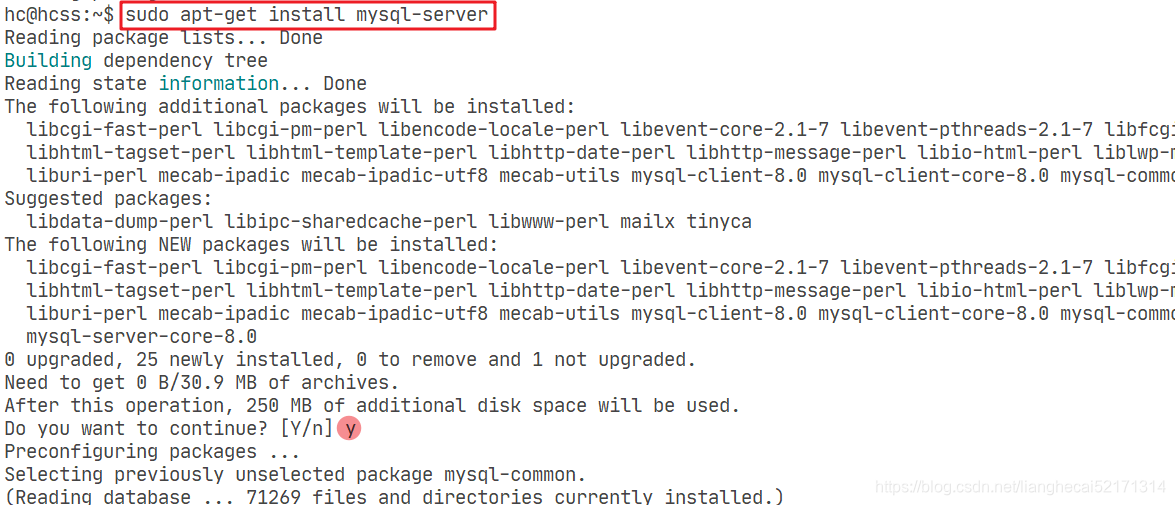Ubuntu中使用apt-get进行软件包管理:
安装:apt-get install name
更新:apt-get update name
卸载:apt-get remove name
查找:apt-cache search name
通过apt 安装MySQL会安装最新版
第一步:更新源
命令: sudo apt-get update

第二步:安装mysql服务
命令: sudo apt-get install mysql-server

第三步:初始化配置
命令: sudo mysql_secure_installation

配置项较多,如下所示:
1
VALIDATE PASSWORD PLUGIN can be used to test passwords...
Press y|Y for Yes, any other key for No: N (选择N ,不会进行密码的强校验)

2
Please set the password for root here...
New password: (输入密码)
Re-enter new password: (重复输入)

3
By default, a MySQL installation has an anonymous user,
allowing anyone to log into MySQL without having to have
a user account created for them...
Remove anonymous users? (Press y|Y for Yes, any other key for No) : Y (选择Y,删除匿名用户)

4
Normally, root should only be allowed to connect from
'localhost'. This ensures that someone cannot guess at
the root password from the network...
Disallow root login remotely? (Press y|Y for Yes, any other key for No) : N (选择N,允许root远程连接)

5
By default, MySQL comes with a database named 'test' that
anyone can access...
Remove test database and access to it? (Press y|Y for Yes, any other key for No) : N (选择N,不删除test数据库)

6
Reloading the privilege tables will ensure that all changes
made so far will take effect immediately.
Reload privilege tables now? (Press y|Y for Yes, any other key for No) : Y (选择Y,修改权限立即生效)

第四步:检查mysql服务状态
systemctl status mysql.service

第五步:配置远程访问
1.配置 bind-address
在Ubuntu下MySQL缺省是只允许本地访问的,使用workbench连接工具是连不上的;
如果你要其他机器也能够访问的话,需要进行配置;找到 bind-address 修改值为 0.0.0.0(如果需要远程访问)
命令:
sudo vi /etc/mysql/mysql.conf.d/mysqld.cnf
#找到 bind-address 修改值为 0.0.0.0(如果需要远程访问)

重启mysql命令:sudo /etc/init.d/mysql restart
2.登录MySQL
命令:sudo mysql -uroot -p
输入用户密码
3.切换数据库
命令:mysql>use mysql;
4.查询用户表命令:
命令:mysql>select User,authentication_string,Host from user;
5.查看状态
命令:select host,user,plugin from user;
6.设置权限与密码
命令:
mysql> ALTER USER ‘root’@‘localhost’ IDENTIFIED WITH mysql_native_password BY ‘密码’; #使用mysql_native_password修改加密规则
mysql> ALTER USER ‘root’@‘localhost’ IDENTIFIED BY ‘密码’ PASSWORD EXPIRE NEVER; #更新一下用户的密码
mysql> UPDATE user SET host = ‘%’ WHERE user = ‘root’; #允许远程访问
#刷新cache中配置 刷新权限
mysql>flush privileges;
mysql>quit;
第六步:开放端口
命令:
sudo iptables -A INPUT -p tcp --dport 3306 -j ACCEPT
sudo iptables -A OUTPUT -p tcp --sport 3306 -j ACCEPT
附:删除MySQL
1.在终端中查看MySQL的依赖项:dpkg --list|grep mysql

2.执行具体删除命令
命令:sudo apt-get remove XXXXX
其中 XXXXX分别为上图红色方块中的内容,比如:
sudo apt-get remove mysql-common
3.查看MySQL的剩余依赖项
命令:dpkg --list|grep mysql
4.继续删除剩余依赖项
命令:sudo apt-get autoremove --purge xxxx
其中xxxx为3中查看到的内容






















 1169
1169











 被折叠的 条评论
为什么被折叠?
被折叠的 条评论
为什么被折叠?










